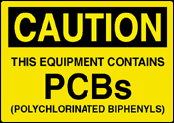



PCBs, or polychlorinated biphenyls, are a class of 209 man-made organic chemicals containing carbon, hydrogen and differing amounts of chlorine. The commercial production of PCBs started in 1929 but their use has subsequently been banned or severely restricted in many countries since the 1970s and 80s because of the possible risks to human health and the environment.
PCBs have been used in wide range of products such as plastics, paints, and adhesives. Since PCBs are resistant to acids and bases as well as to heat, they have also been used in electric equipment, heat transfer fluids and lubricants. Disposal of waste that contains PCBs in landfills or incinerators can lead to environmental contamination.
PCBs can persist in the environment and accumulate in animals and along the food-chain. Humans may be exposed to PCBs by ingesting contaminated food and water or inhaling contaminated air. In the human body PCBs can remain in fatty tissues and in the liver and may be transferred from mother to child through the placenta or breast milk. The speed at which PCBs are transformed in the body and the extent to which they are either stored or excreted depend on the type of PCB.
Studies on humans and animals have shown harmful effects on fertility. Furthermore, exposure of the child during pregnancy or through breast-feeding can affect its development. Effects on the immune system have been observed in animals, in children exposed to PCBs during development in the womb, and in adults exposed through PCB-contaminated food. Groups of workers that have been exposed to high levels of PCBs (as well as to other chemicals) have shown an increase in certain cancers.
Based on these findings, a tolerable daily intake for humans of 20 ng/kg body weight per day has been established for a commercial PCB mixture with relatively high chlorine content (Aroclor 1254).
This text is a summary of: IPCS - WHO
Polychlorinated biphenyls : Human health aspects. Concise international chemical assessment document 55
Section 1 Executive summary![]()

This summary is free and ad-free, as is all of our content. You can help us remain free and independant as well as to develop new ways to communicate science by becoming a Patron!